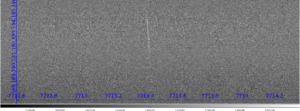Project area/S
- Transient Universe : fast radio bursts (FRBs), pulsars, radio transients
Project Details

Example of a single pulse from a bright pulsar B0950+08 detected with EDA2 around 200 MHz
Fast Radio Bursts (FRB) are one of the most intriguing transient phenomena discovered only 15 years ago. Their localisations and redshift measurements of multiple FRBs confirmed their extragalactic origin and extreme energies of the order of 1039 ergs, which are emitted over milli-second intervals. However, full understanding of FRB sources and underlying physical mechanisms powering these extreme events still awaits full explanation. About 10% of FRBs are observed to repeat, and some repeating FRBs were discovered in the southern hemisphere. Additionally, a few repeating FRBs, like FRB 20180916B, were observed at frequencies down to even 110 MHz. Repeating FRBs are the most promising targets for follow-up multi-wavelength observations and detections at low radio-frequencies, which may eventually lead to explanation of their physical mechanisms.
The goal of this project is to process existing data and record more data on the selected repeating FRBs in order to detect their pulses at frequencies below 300 MHz. The project will use data from the Engineering Development Array 2 (EDA2), which is one of the prototype stations of the low-frequency Square Kilometre Array (SKA-Low) telescope. EDA2 provides observing flexibility, reasonable sensitivity and quick data processing turn around. In the station beam mode it can record large bandwidth (30 MHz or more) covering the field-of-view of the order of a few square degrees. The recently developed processing pipeline is based on the ASKAP FRB search software Fredda,and has been demonstrated to detect single pulses from bright pulsars (see the attached image). This pipeline will be applied to search for higher DM pulses from FRBs.
The specific goal for this project is to process a few tens of hours of data and detect pulses from these FRBs, which would be the first FRB detections by Australian-based low-frequency telescopes.
If no pulses are detected, the large amount of data will enable us to place strict limits on repetition rates and brightness of the pulses. The efficiency of the pipeline will be verified by comparison with different software (PRESTO single pulse search) and injection of mock FRBs into the data.
The results are expected to lead to a short publication and the summer intern will co-author this publication.
Student Attributes
Academic Background
Programming in scripting languages (bash and python). It may be sufficient if the student is proficient in programming in some other language and can quickly learn python.
Astronomy/astrophysics background will be useful, but is not critical for this project.
Computing Skills
Python, bash scripting, Linux environment
Training Requirement
Introduction to HPC computing. If the candidate does not know python some basic training will be useful too.
Project Timeline
| Week 1 | Inductions and project introduction |
| Week 2 | Initial presentation |
| Week 3 | Get familiar with the data (high time resolution complex voltages from the EDA2 station beam, resulting dynamic spectra and pulse candidates generated by the Fredda software) and processing software. Execute the processing pipeline and inspect candidates from one dataset (about 1 hour of data) in order to master the entire process. |
| Week 4 | Prepare a list of repeating FRBs (max. 3 objects) which can be observed with EDA2 (sufficiently southern declination etc.). Start performing observations and data processing. |
| Week 5 | Continue observations of selected targets (at least a few hours of data per target per week).
In parallel process all the recorded data, inspect candidates and write short summary reports about each observations listing the most interesting candidates. The candidates may be of astrophysical or non-astrophysical origin – for example interesting and/or unusual examples of radio-frequency intereference (RFI). Record and classify the most interesting candidates. |
| Week 6 | Continue the same tasks as in Week 5. Try to estimate efficiency of the search pipeline, by injecting mock FRB-like pulses into the data and running processing software. Measure the efficiency of pulse detection as a fraction of correctly identified pulses to the total number of injected FRBs. |
| Week 7 | If interesting astrophysical pulse candidates are detected focus analysis on these candidates. Derive upper limit on the repetition rate, brightness of the pulses from the observed repeating FRBs, and one-off FRB rate. Establish the fluence sensitivity of the FRB search in Jy ms. |
| Week 8 | Continue the tasks from Week 7, and finalise the results from the previous weeks. |
| Week 9 | Final presentation |
| Week 10 | Final report |
